
The tenor ukulele is the largest uke that is still tuned with what could be considered standard ukulele tuning.
By standard ukulele tuning, I mean GCEA tuning with either a high re-entrant G or a low G.
The larger ukes, baritone and bass, both use their own tuning systems, separate from the other ukuleles.
Now let’s get down to the topic at hand and discuss some tenor ukulele tuning topics.
Contents
- How is a Tenor Ukulele Tuned?
- How do you tune a tenor ukulele low G tuning?
- Is a Tenor Ukulele tuned the Same as a Soprano?
- 6-String Tenor Uke Tuning
- 8-String Tenor Uke Tuning
- Tuned Tenor Ukulele String Tension
- What are the Fretboard Notes of a Tenor Ukulele?
- How to use an Electronic Tuner to tune a Tenor Ukulele
- What are the Frequencies used for Tenor ukulele tuning?
- How do I Tune a Tenor Banjo Ukulele?
- What are the Common chords of a Tenor Ukulele?
- Are Tenor Ukuleles tuned Differently?
- Why is the tenor ukulele tuned with Re-entrant tuning?
- Can I tune a Tenor Ukulele with Baritone (DGBE) tuning?
- Tuning an Electric Tenor Ukulele
- Tenor and Concert Ukulele Tuning Comparison
- Tenor Ukulele vs. Baritone Tuning
- Tenor Ukulele Scale
- Tenor Ukulele Range
How is a Tenor Ukulele Tuned?
Traditionally, a tenor ukulele is tuned to GCEA re-entrant tuning.
The re-entrant means the top G string is actually higher than the next string (C), which is actually the lowest string.
Here’s a good video of the pitches used in High G tuning so you can tune to your uke to the pitches.
Start off with each string loose, then slowly tighten it and pluck it as the desired pitch plays until both the string and the desired pitch sound identical.
You’ll notice when a string is in-tune to the desired pitch, there will be no “warble” in the sound as both are played simultaneously.
Here’s a diagram showing how to tune a tenor ukulele to itself in High G, GCEA tuning.

Start with the lowest C string.
Then match the E string with the C string held at the 4th fret.
Then match the G string with the E string held at the 3rd fret.
Then match the A string with the G string held at the 2nd fret.
And you’re all set!
How do you tune a tenor ukulele low G tuning?
Another option for tuning your tenor uke is Low G Linear Tuning.
Linear tuning means the uke is tuned like most stringed instruments with the strings in order from the top string having the lowest pitch, to the bottom string having the highest.
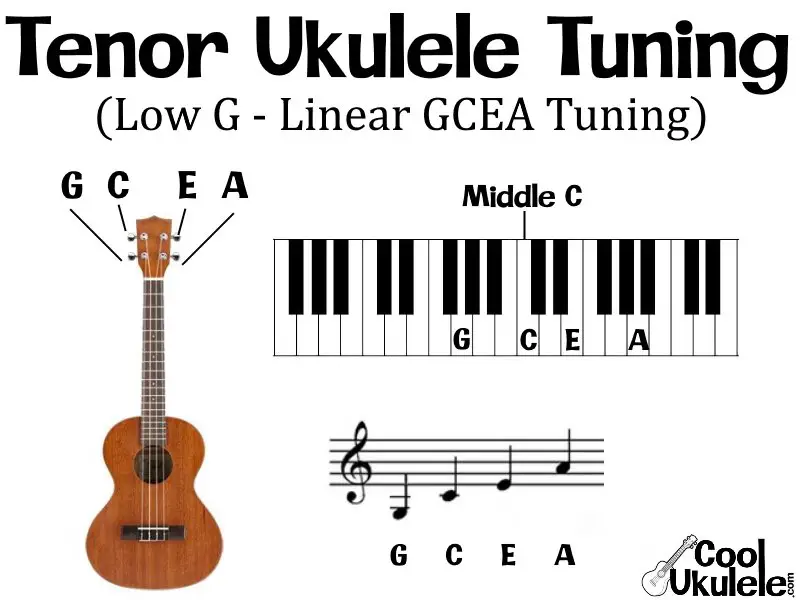
This gives the uke a deeper sound and higher range of available notes, but takes away the bright more typical ukulele sound.
Here’s a diagram showing how to tune a tenor uke to itself in low G tuning.

Start with the G string, then move your way up to the higher strings from there.
For a detailed comparison between high-G and Low-G tuning, check out our High G vs. Low G Ukulele Tuning article.
Is a Tenor Ukulele tuned the Same as a Soprano?
Yes. By common practice, a tenor and soprano ukulele are both tuned to the same notes (GCEA).

Both ukes can also be tuned with Low G tuning, but it is more common with the tenor.
Check out our soprano ukulele tuning article for more specific information on tuning that size of ukulele.
6-String Tenor Uke Tuning
A 6-string tenor ukulele typically is tuned similarly to the standard GCEA tuning (it can be high G or low G), except that the C and A strings are doubled.
The doubled C string is often tuned an octave higher or lower.
Doubled strings are played together as if it was one string.
8-String Tenor Uke Tuning
An 8-string tenor, on the other hand, is typically tuned with each string doubled (4 sets of 2) and still tuned to GCEA, but the C and G string pairs are not identical.
The G string pair includes both a high G and a low G string.
And the C string pair includes both the standard middle C and the next C up (one octave higher).
Tuned Tenor Ukulele String Tension
When a tenor ukulele is tuned, the tension on the strings is approx. 39 pounds.
This number can change depending on the types of strings used and the exact construction of the ukulele.
What are the Fretboard Notes of a Tenor Ukulele?
Here’s a fretboard note chart for the tenor ukulele in GCEA tuning.
The picture goes up to fret 15 but notice that the notes all repeat at fret 12 (1 octave).
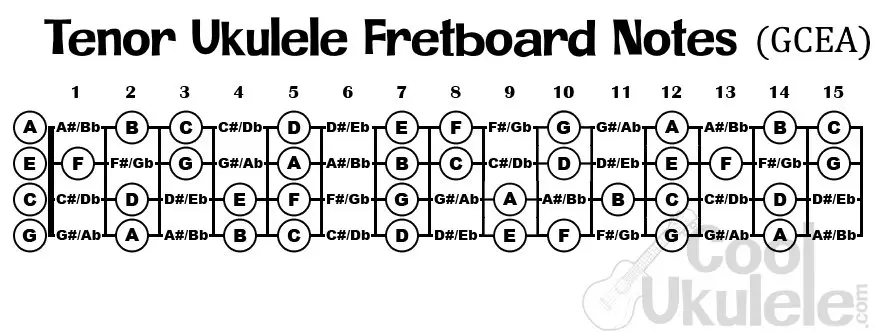
For low G tuning, the fretboard notes are the same (except the G string’s notes are an octave lower), but I decided to make a separate image for Low G Tenor tuning in case it comes in handy for someone.
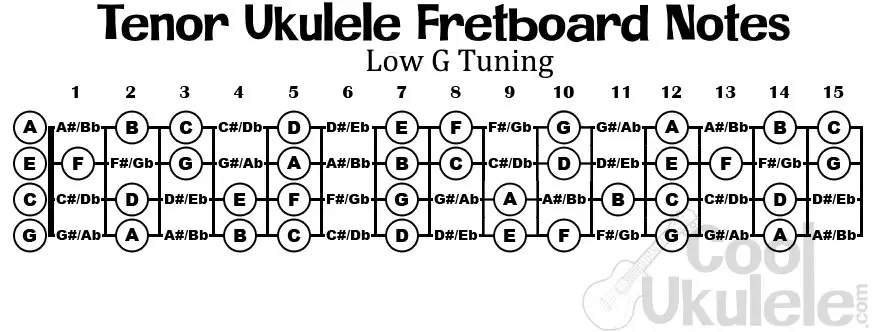
How to use an Electronic Tuner to tune a Tenor Ukulele
Here’s a great video to guide you with using an electronic clip-on tuner to tune your tenor.
Most electronic tuners you will come across will be clip-on tuners that clip-on to the head of your uke (hence the name).
When you pluck a string, the tuner reads the vibration and displays the closest note (F#, C, Db, etc.) to the current frequency of the string, and will usually indicate whether the pitch is too high, too low, or exactly on the mark.
Some tuners will have specific settings for instruments and some will be chromatic and usable for any instrument.
The video only shows high G tuning, but the same steps can be used for Low G.
The frequencies below can be used for tuners that show frequencies.
What are the Frequencies used for Tenor ukulele tuning?
Here’s a table of the frequencies used when tuning a tenor uke to High G tuning.
| Uke String | Tuning Frequency |
|---|---|
| G4 (High G) | 392 Hz |
| C4 | 261.63 (often rounded to 262) Hz |
| E4 | 329.63 (often rounded to 330) Hz |
| A4 | 440 Hz |
And here’s a similar table with the Frequencies for Low G tenor uke tuning.
| Uke String | Tuning Frequency |
|---|---|
| G3 (Low G) | 196 Hz |
| C4 | 261.63 (often rounded to 262) Hz |
| E4 | 329.63 (often rounded to 330) Hz |
| A4 | 440 Hz |
How do I Tune a Tenor Banjo Ukulele?
Standard wood-body tenor ukes and banjo tenor ukes are both typically tuned with the same options (high G, low G, etc.).
The banjo body just alters the sound/volume of the instrument, but the playing, whether a banjo or wood-body ukulele, remains the same.
For more info on banjo ukulele tuning, check out our dedicated Banjo Ukulele tuning article.
What are the Common chords of a Tenor Ukulele?
The following is a chord chart of the common chords on a GCEA tuned Tenor ukulele.
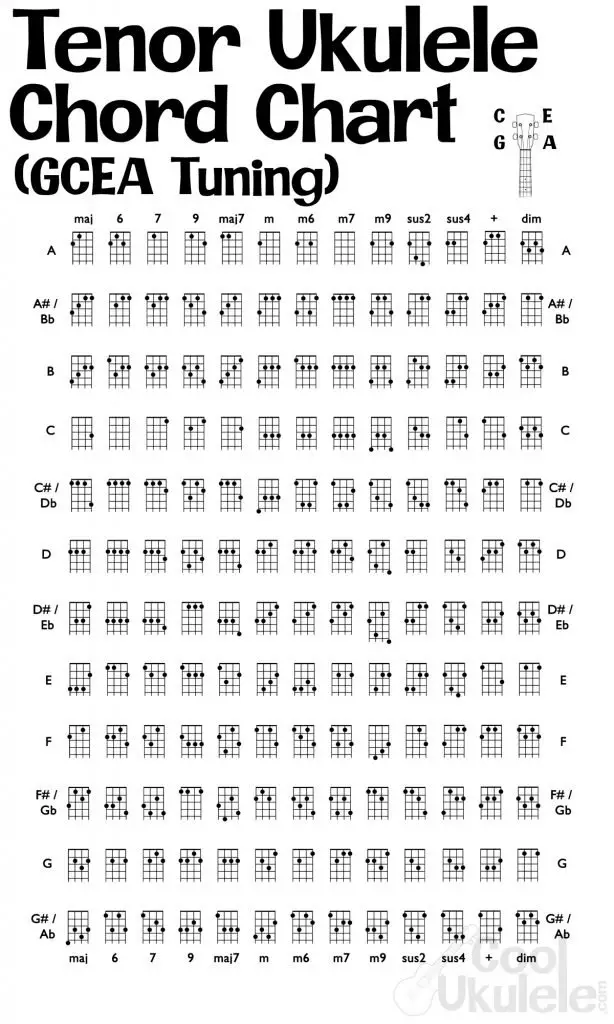
Are Tenor Ukuleles tuned Differently?
This question really depends on what is meant by “differently,” or more specifically, differently from what?
Likely the question is coming from the perspective of the soprano ukulele as this is the most common.
As stated above, the tenor and soprano ukulele are both traditionally tuned with the same setup (GCEA re-entrant), and can also both often be tuned to low G (GCEA linear) tuning, though the latter is more common on tenor than soprano.
The concert ukulele is also usually tuned in the same manner, but the baritone uses a different system (DGBE linear).
Why is the tenor ukulele tuned with Re-entrant tuning?
Re-entrant tuning is used on most ukuleles.
It just means that, unlike on most stringed instruments, the top string is higher than the next string down.
Some sources say the origin of this tuning style was the use of strings made from animal gut.
According to these sources, the animal gut either couldn’t be thick enough or it was too expensive, and so a higher string was used on top rather than lower.
Regardless of why re-entrant tuning was originally used, the end result is that ukuleles in this tuning setup have a brighter, happier sound when strummed, as both down strums and up strums end on a relatively high pitch.
Our minds likely associate the higher pitches to happier feelings due to their connection with children’s voices, baby animals, birds chirping, etc.
As opposed to deeper-pitched sound sources which the mind could associate with thunder, earthquakes, dangerous animals, etc.
Can I tune a Tenor Ukulele with Baritone (DGBE) tuning?
Yes. You will need a set of strings designed for this purpose.
There are string sets available for tenor ukulele with both DGBE linear (standard baritone) tuning, as well as DGBE high-D re-entrant tuning.
Tuning an Electric Tenor Ukulele
Tuning an electric tenor ukulele is no different than tuning a standard acoustic tenor uke, so the steps/methods above apply identically.
This goes for other sized ukuleles (and instruments in general) as well, being electric does not typically alter the instrument’s tuning options.
Tenor and Concert Ukulele Tuning Comparison
The concert ukulele is tuned identically to the tenor.
Both are traditionally tuned to GCEA with a high, re-entrant G string.

Both are also sometimes tuned with low-G tuning, but more commonly on the tenor ukulele than the concert.
Tenor Ukulele vs. Baritone Tuning
Baritone Ukuleles are tuned with DGBE linear tuning.
Linear here means the top string is the lowest, and each string under it is higher than the previous, with the bottom string being the highest.
This is similar to Low-G tenor ukulele tuning, except down one 5th (G to D, C to G, etc.).
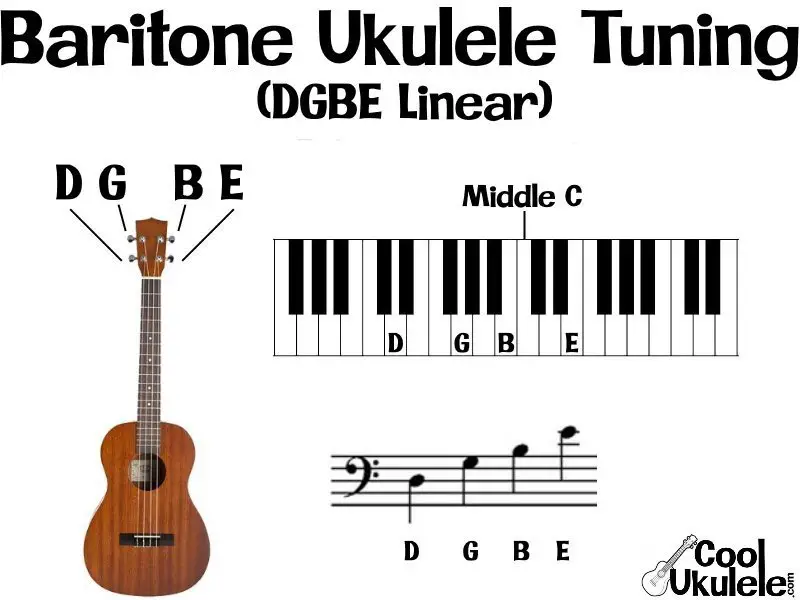
For a more in-depth comparison between the tenor and baritone ukuleles, check out the Baritone vs. Tenor Ukulele article.
Tenor Ukulele Scale
The tenor ukulele’s scale is approximately 17 inches.

In ukulele construction, the scale length is the distance from the saddle (part of the body which holds the strings) to the nut (part on the neck that keeps the strings in position and directs them to their tuning parts).
On a tenor banjo ukulele, the saddle would be the bridge, the wooden part that rests on the drum head and keeps the strings in position.
Tenor Ukulele Range
The range of your tenor uke depends on 2 factors. 1. the tuning system used (normally high G or low G) and 2. the number of frets on your instrument.
The tuning system will impact the lowest note of your range (Middle C for high G tuning, and the G below middle C for low G).
The number of frets on your uke’s fretboard will impact the highest available pitch in its range.
If your ukulele had 12 frets, the highest available note would be A5 (one octave above A4 which is the A above middle C).
But most likely your tenor uke has around 18 frets, which means the highest available note would be Eb/D#6 (2 octaves above the Eb above middle C) as you get an additional 6 pitches from the 6 frets.
Here’s a table of ranges for a tenor ukulele with 18 frets.
| Tuning System | Lowest Note of Range | Highest Note of Range |
|---|---|---|
| Low G | G3 | Eb6 |
| High G | C4 | Eb6 |
